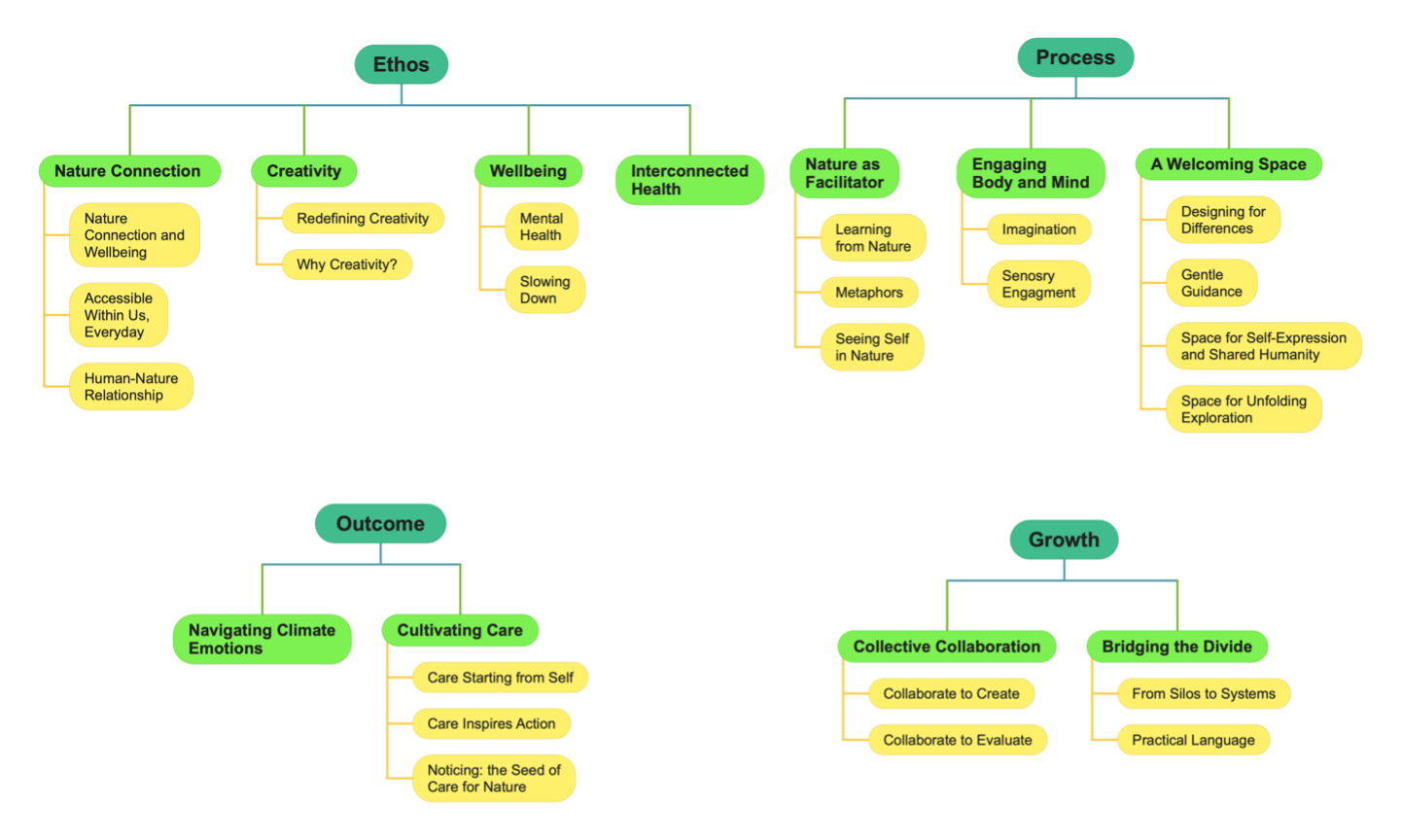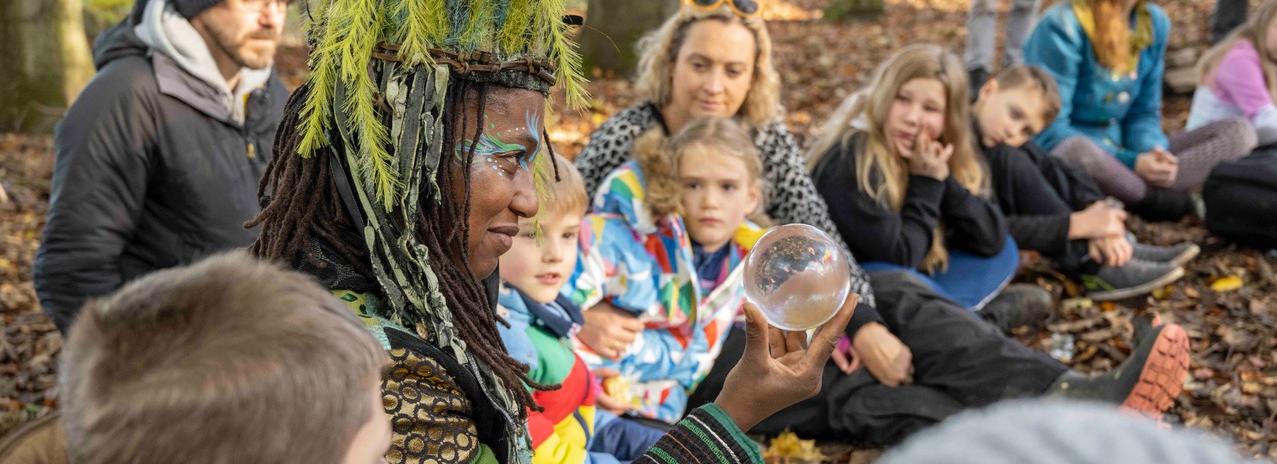This is a summary of research undertaken in 2023-4 by Creative Health Masters student Manal Aldabbagh in partnership with the Culture, Health & Wellbeing Alliance (CHWA). It includes case studies, key findings and recommendations for facilitators, researchers and funders.
The research explores the link between creative and planetary health, and the intersection of creativity, nature, and wellbeing in community-based projects. It aims to identify the key elements in creative community-based projects addressing human and environmental health and wellbeing.
The findings are intended to provide a deeper understanding of practice-based approaches and offer insights and recommendations for facilitators, funders, and researchers working at the intersection of creativity, wellbeing, and environmental sustainability. This collaborative approach ensures that the insights are comprehensive and inclusive.
Case studies
You can read a selection of case studies by clicking on the links below:
- Look Again
- Green Close
- Outside Lives
- Rowanbank Environmental Arts & Education CIC
- Think Like a Tree / Think Like a Forest
Methodology
The research used a qualitative approach. Semi-structured interviews were conducted with ten UK-based practitioners who directly facilitated projects and workshops addressing human wellbeing through creative nature-based approaches. Reflexive thematic analysis was employed to explore their experiences and insights, identifying core themes that contribute to the success of these projects.
Key Findings
The research identified nine key elements under overarching themes: ethos, process, and outcomes. In addition, two elements were identified that provided elements essential for growth. (You can also read this in a chart at the end of this article.)
Ethos: The Project’s Guiding Principles
The ethos of these projects is rooted in the principle that human and planetary health and wellbeing are deeply connected. Facilitators take a creative approach as a mechanism of self-reflection and emotional exploration to foster a connection with nature. Redefining creativity as accessible to everyone and as a process rather than an end goal. Another key element is nature connection, emphasising the reciprocal nature of our relationship to nature.
Process: How the Projects are Designed and Delivered
These projects focus on creating an inclusive and non-judgmental space where participants can engage in nature-based activities at their own pace. A key element is the importance of sensory engagement; all participants expressed the need to encourage participants to engage their senses in the natural environment and connect to themselves. Nature plays an active role in project activities through metaphor, learning from nature and seeing oneself in the natural surroundings.
Outcome: The Impact on Participants and the Environment
The outcomes of these projects show a positive impact on both human wellbeing and planetary health. Participants experienced improved mental health and felt more connected to nature and their communities. The projects also show that developing a sense of care towards their environment encouraged meaningful, sustainable actions. An important intentional outcome was to support participants in navigating climate anxiety, transforming feelings of fear and helplessness into empowerment and action, and creating a sustainable impact on both individuals and the planet.
Growth: Expanding Impact and Sustainability
Sustaining and expanding these projects requires collaborative partnerships, particularly between facilitators, researchers, and environmental experts, to enhance project design and evaluation. Many facilitators lack resources for impact assessment, highlighting the need for academic collaboration. Bridging the gap between community practice, academia, and healthcare is essential, with a focus on integrated approaches and accessible language to foster broader engagement. Strengthening these connections will support creative community-based projects’ long-term success and scalability.
Recommendations
Recommendations for Facilitators
- Integrate Nature Connection into Daily Life: Facilitators can encourage nature connection by helping participants find simple, everyday interactions with nature in their daily lives.
- Emphasise the mind-body connection: Incorporate sensory engagement and imagination stimulation through slow and mindful practices. This can include activities that draw attention to sounds, smells, and images, reflective exercises, or unstructured time during sessions.
- Redefine and Expand Creativity: Encourage participants to broaden their understanding of creativity and facilitate activities highlighting creativity as a dynamic process. This approach can empower participants to explore creative expression in diverse ways.
- Cultivate a Welcoming and Inclusive Space: Create a safe, non-judgmental environment that encourages open-ended exploration. Balance structured activities flexibly to meet participants' needs and respect individual differences and emotional capacities, especially in nature-based projects.
- Address Climate Emotions Thoughtfully: Be mindful of climate-related emotions like eco-anxiety or grief. Create spaces for expression and provide tools like mindfulness practices to help participants navigate these feelings constructively.
- Utilise Nature as a Co-Facilitator: Use nature as a teacher and co-facilitator in sessions. Incorporate natural metaphors and sensory experiences to help participants reflect on personal growth and interconnectedness with the environment, emphasising that caring for nature is caring for oneself.
Recommendations for Researchers
- Explore Interconnectedness Further: Researchers should continue investigating the interconnectedness of human wellbeing and planetary health within creative community projects. More in-depth studies are needed to explore these projects, their mechanisms of impact, and the role of facilitators.
- Develop Accessible and Practical Terminology: With input from facilitators and community members, researchers should develop more accessible language for terms like "planetary health" to ensure better understanding.
- Examine the Role of Sensory Engagement: Limited research explicitly focuses on the impact of sensory engagement on human and planetary wellbeing. Researchers should explore this area further, considering how multisensory experiences can deepen connections to nature and enhance project outcomes.
- Collaborate on Project Evaluation: Researchers should collaborate with facilitators to develop comprehensive evaluation processes assessing human wellbeing and planetary health outcomes. This might involve creating new measurement tools or adapting existing ones.
Recommendations for Funders
- Support Flexible and Adaptable Projects: Funders should prioritise funding projects designed to be flexible and adaptable to different community needs. Projects that allow participant-led exploration and can be tailored to various contexts are more likely to achieve sustainable outcomes.
- Invest in Collaborative Initiatives: Encourage and fund collaborative efforts that bring facilitators, researchers, and other professionals across disciplines. Collaborative projects that integrate diverse expertise are better positioned to address the complex challenges of human and planetary health.
- Facilitate Accessible Language and Communication: Support initiatives to develop and disseminate accessible language and communication strategies. Projects that effectively engage a broader audience through relatable and practical language are more likely to succeed and have a wider impact.
- Encourage Project Evaluation and Learning: Allocate resources for comprehensive project evaluation, allowing facilitators and researchers to rigorously assess their initiatives' impact and generate evidence to advance the field.
By implementing these recommendations, facilitators, researchers, and funders can contribute to developing creative community projects that enhance human wellbeing and promote the health of our planet.


